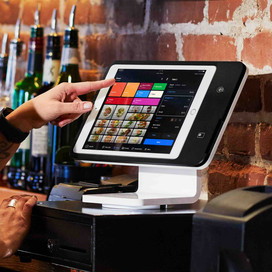Table of contents
The words “sales tax compliance” can put even the most seasoned restaurant owner on edge — and for good reason. Sales tax and everything that goes along with it is a time-consuming pain in the you-know-what to manage, especially for busy restaurant owners. And the stakes are high. Simple mistakes, missed deadlines, and miscalculations, even if unintentional, can have costly consequences.
Don’t find yourself facing hefty fines, or worse yet, an audit. Keep reading to get the skinny on sales tax compliance for restaurant owners, what happens during an audit, and how using technology like Square for Restaurants can save you time, simplify sales tax, and keep you in the good graces of your friendly state auditor.
To kick things off, let’s do a little sales tax crash course.
Restaurant sales tax 101
Unfortunately, part of your job as a restaurant owner is to be the middleman between your customers and your state or local taxing jurisdictions. They are trusting you to collect and remit the proper amount of sales tax from each transaction.
As if that isn’t enough, they also require you to file sales tax returns multiple times a year that include a breakdown of all your taxable sales and purchases. In short, it’s confusing, it’s a hassle, and mistakes can cost you big time.
So how much money do you have to set aside? Figuring out your sales tax rate isn’t always straightforward. Here’s the short version on why:
- 45 U.S. states and the District of Columbia legally require businesses to charge sales tax.
- 38 of these 45 also have local tax rates that must be added to the state tax rate.
- Some cities require restaurants to add a separate dining-out tax to every ticket total.
- Some things are taxable (most tangible items) and others are not (many services).
- Tax collected on cash tips can be complicated, hard to prove, and confusing to track.
- Dine-in and to-go orders may have different tax implications and rates.
Confounding tax laws mean the onus is on you to do your homework, get your state and local rates straight, and keep detailed records at the ready.
Why all restaurants (including yours) are at risk of an audit
In California, nearly one in four food service establishments is noncompliant. With that stat in mind, it should come as no surprise that restaurants are popular targets for sales tax compliance scrutinization. But what, exactly, would cause your local tax authority to turn its attention to your restaurant?
Former senior tax auditor for the State of California Robert Schulte knows firsthand. Below, he explains the three most common reasons restaurants get audited:
- Lots of cash transactions
Why does accepting cash make you more likely to be audited? Primarily because it’s more difficult to prove how much money is coming and going. There’s also typically more human error involved in calculations and counting, which can lead to more frequent reporting mistakes. (Tip: If your business regularly handles cash, a smart point-of-service system, like Square for Restaurants, makes it easier to prove your profits.) - High employee turnover
The bar and restaurant industry is known for high employee turnover. Not only does that present its own set of challenges, but it can also lead to scrutiny from tax authorities. If your state tax hotline regularly receives calls from disgruntled ex-employees calling in to report violations, your restaurant is going to find itself on an auditor’s short list of places to visit in a big hurry. Don’t let this little-known red flag catch you off guard! - Volatile inventory
Do you serve fresh seafood or top-shelf liquors? Significant spillage and spoilage reported on volatile inventory that costs a pretty penny is likely to attract auditor scrutiny.
What happens during a sales tax audit
Auditors conduct a thorough investigation to pinpoint the existence of (and, if found, the extent of) a sales tax violation. There are two primary processes auditors use to accomplish this. Former California senior sales tax auditor Robert Schulte explains:
Purchase order vs. reported sales analysis
Revenue can’t exist without inventory, meaning restaurants must buy something (food, drinks, etc.) in order to sell something. Auditors know that every food and drink order has its own purchase order that lists details of the transaction, including quantities, item names, and cost. So how is this data used to identify sales tax violations?
To make the math easy, let’s say a deli orders 1,000 fresh-baked rolls per week but reports that it only sold 450 sandwiches made with said rolls per week. If auditors see sales that don’t line up with inventory purchase orders on multiple occasions, chances are, something is off. No restaurant owner is going to knowingly toss money in the form of 550 stale deli rolls into the garbage on a weekly basis.
Reverse audits and bar pour tests
Establishments that serve beer, wine, and spirits have a unique challenge when it comes to combating spillage. Even the most seasoned bartender tends to spill a bit and overpour when they’re in a hurry to make drinks, keep customers happy, and earn tips. And that’s okay, within reason. But if spillage is excessive, or inventory and revenue numbers don’t line up, there may be a problem. To figure out if additional tax is owed, an auditor must first calculate how much revenue each bottle of liquor can generate. How?
- Calculate drinks per bottle.
If every “single” drink ordered contains 1.5 ounces of spirits, and a standard one-liter bottle of alcohol holds 33.8 ounces, that works out to 22.5 drinks with zero spillage. Accidents happen, and humans are not perfect, so some spillage is expected and allowed. - Factor in allowable spillage.
Assuming an average spillage rate of 5–15%, a one-liter bottle of whiskey should yield 17 to 20 single-shot drinks. If whiskey costs $5 per shot, each bottle should generate $85–$100 in revenue. - Compare purchase orders to revenue.
If three months’ worth of purchase orders are compared to total drink sales and the numbers don’t add up, additional taxes may be owed. - Conduct a pour test.
If an auditor believes your spillage reports are high, they’ll conduct a pour test. During the test, the auditor will order a shot and measure the volume of the alcohol in their drink. Auditors typically do this undercover during peak business hours and frequently come back two to three times. The goal is to get comprehensive data that closely resembles business as usual. - Calculate additional tax owed.
An auditor will simply multiply the total number of bottles purchased by the expected revenue per bottle to reveal how much tax should have been paid. For example, if a bar has projected sales of $40,000 but only reported $25,000, it will be asked to pay tax on the discrepancy. In this case, $40,000 – $25,000 = $15,000, so the bar would owe tax on that $15,000.
If you get audited, being able to quickly provide any evidence your auditor asks for can help expedite the process. This can include things like purchase orders for a specific product or sales reports from a particular date range, so organization is key.
If an audit doesn’t resolve in your favor, you may find yourself facing penalty fees and back taxes. These costs can be difficult for up-and-coming businesses to absorb, and if you’re unable to pay, the state can garnish your wages or use other unpleasant tactics to collect their cash.
As you can see, when it comes to sales tax compliance, ignorance is not bliss — it’s expensive. So what can you do to be prepared and stay compliant?
Tip: Leverage Square’s smart partnerships with sales tax experts to help you file sales tax returns and make all your deadlines.
Do your homework
In order to be sales tax compliant, you need to understand what that means for your restaurant. Research local laws and determine:
- Your state, city, and county tax rates and responsibilities
- If you own multiple locations, how to accurately calculate tax rates for each location
- Which POS system is the best fit for your bar, restaurant, cafe, or coffee shop’s needs
- Tax schedules and deadlines for all applicable local taxing authorities
- Which tax forms you need to fill out and where to send your paper tax returns
- How to accurately configure sales tax rates in your register software
It sounds like a hassle because it is. But the good news is, you don’t have to do it all yourself.
Get smart (software)
Very few restaurant owners are well-versed in state sales tax compliance laws, and that’s okay. In today’s tech-driven world, you can invest in software tools designed to simplify every aspect of your day-to-day operations, including compliance. So where should you start? Invest in a POS system that’s built for restaurants.
Ideally, your POS should have:
- Intuitive menu-building tools with modifiers and categories to simplify ordering
- Readily available, easily searchable transaction records for all tender types
- Real-time POS reporting that lets you access the data you need, when you need it
- The ability to view and manage dine-in, carry-out, and delivery orders in one place
- Smart integrations with third-party tools that allow you to outsource complex processes
Thanks to intuitive programming, comprehensive reporting abilities, and strategic partnerships, Square for Restaurants checks all the boxes listed above and then some. This well-rounded POS lets dining establishments of every shape and size build a custom system that meets their specific needs. But what about compliance? Square is fully integrated with LumaTax, which means busy business owners can leave the complicated tax stuff to the experts, like tax filings, which are automated with LumaTax.
When you think about all the time you’ll save, it’s easy to see why smart software is well worth the investment.
Critical considerations for continued compliance
Now you know:
- What causes audits and how to mitigate risks
- How and why smart software helps you stay organized and compliant
Sales tax compliance isn’t a set-it-and-forget-it process. Once you’re set up for success, watch for state and local law changes that affect your rates, regularly backup digital files, scan and organize non-digital paperwork every day, and set reminders to check for POS software updates on a monthly basis to stay compliant and keep things running smoothly.
Staying on top of all the to-dos you have to tackle to keep your doors open every day is enough to worry about. You don’t need to be burdened with an audit on top of it! Follow the guidelines discussed above and consider using Square for Restaurants to simplify sales tax compliance.
About LumaTax
LumaTax completely automates sales tax compliance — preparing and filing returns, and remitting payments — by connecting directly to your Square account. With LumaTax, you never have to worry about filing another return, paying another penalty, or defending yourself from the dreaded sales tax audit again.
![]()












